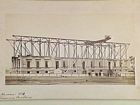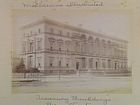Destined for the strongrooms of the major banks and government offices, between the years 1853 and 1857, six million ounces of gold were brought from Victoria’s diggings under armed guard to Melbourne. Soon the banks and the vaults of the first government Treasury offices were at bursting point. In 1857, therefore, the government invited 18-year-old draftsman John James Clark to design a new Treasury building, where the storage of gold would be centralised. Clark had arrived in Victoria in 1852 and while he obtained work in the colonial architect’s office, other members of his family decided to try their luck at the goldfields.
The first Treasury office was located in William Street, at the western end of town. Government offices chose this vicinity in an effort to be close to Flagstaff Gardens so that messages from the Port of Melbourne could be readily received. Later, with the advent of telegraphic communications, public buildings became more widely dispersed throughout the city.
One of the first large government buildings erected in Melbourne after the first goldrushes, the Spring Street Treasury Building was built between 1857 and 1862. The project would be heralded as one of the first to use a travelling crane and steam stone-sawing machine during construction.
The three-storey building was constructed of Bacchus Marsh freestone with bluestone foundations. The choice of materials was, to a large degree, potluck, for in a new country, the endurance of the materials available had not yet been time-tested. It would, however, unfortunately, prove to be a problem. The sandstone had already beginning to decay by the 1860s therefore the terrace balustrades were later built in the Tasmanian sandstone similar to that used in the State Library and Town Hall.
The vaults within the building most likely stored gold between 1867-8 and 1871-2. The Gold Office moved from the Customs House to the Treasury in Spring Street around 1866-7. In 1872, the holdings of gold moved to the Royal Mint in William Street.
Due to its prominent location the Treasury has played host to many a public celebration; the welcome and farewell of Governors, marks of respect for Queen Victoria’s death and victories during war times. Quite often during these occasions, the building was draped in bunting and flags, and later electric lights. Presently the Treasury Building is the site of the Gold Museum, which explores the influence of the discovery of gold on Melbourne.
After major restoration work being completed between 1992-4, the building’s historical links have been maintained by the fact that the Governor’s office is still situated on the first floor, and by the Executive Council meetings that have taken place there since the 1860s.



